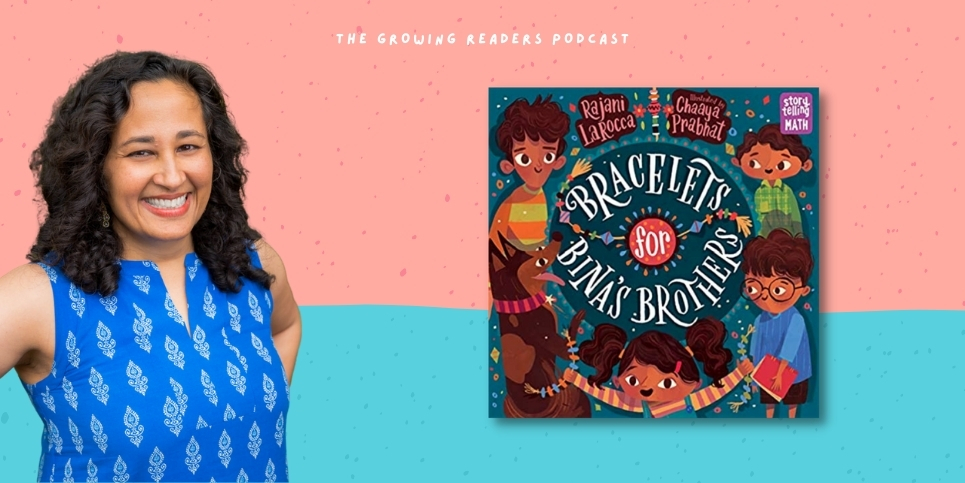An interview with Rajani LaRocca
The Children’s Book Review
In this episode of the Growing Readers Podcast, I talk with author Rajani LaRocca about Bracelets for Bina’s Brothers, a picture book that celebrates diversity, math, and the power of storytelling!
Rajani LaRocca has burst into the world of children’s books with a bunch of incredible titles and there are many more on the way. Born in India, raised in Kentucky, she now lives in the Boston area, where she practices internal medicine and writes her heart out, sharing stories that connect us to other people across distance, time, and culture. We talk mostly about her latest picture book, Bracelets for Bina’s Brothers, part of the Charlesbridge Storytelling Math series. We also chat briefly about her stunning middle-grade novel, Red, White, and Whole, written in verse about an Indian American girl whose life is turned upside down when her mother is diagnosed with leukemia.
Listen to the Interview
About the Book
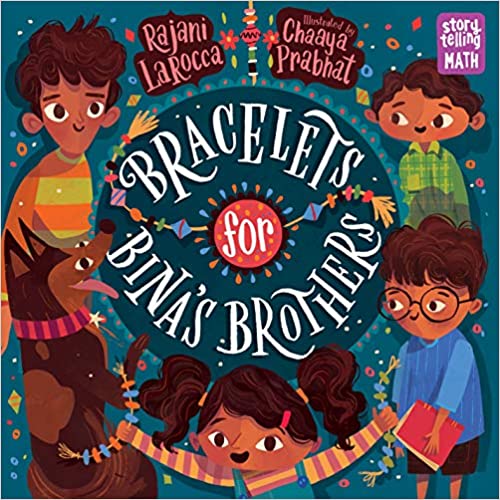
Bracelets for Bina’s Brothers
Written by Rajani LaRocca
Illustrated by Chaaya Prabhat
Ages 3-6 | 32 Pages
Publisher: Charlesbridge | ISBN-13 : 978-1623541293
Publisher’s Synopsis: For the Hindu holiday of Raksha Bandhan, Bina is determined to make beaded bracelets for her brothers all by herself. She finds out which colors her brothers like and dislike and sets to work. Working with her every-other-one beading pattern causes Bina to discover something new about patterns–and her brothers.
Storytelling Math celebrates children using math in their daily adventures as they play, build, and discover the world around them. Joyful stories and hands-on activities make it easy for kids and their grown-ups to explore everyday math together. Developed in collaboration with math experts at STEM education nonprofit TERC, under a grant from the Heising-Simons Foundation.
Buy the Book
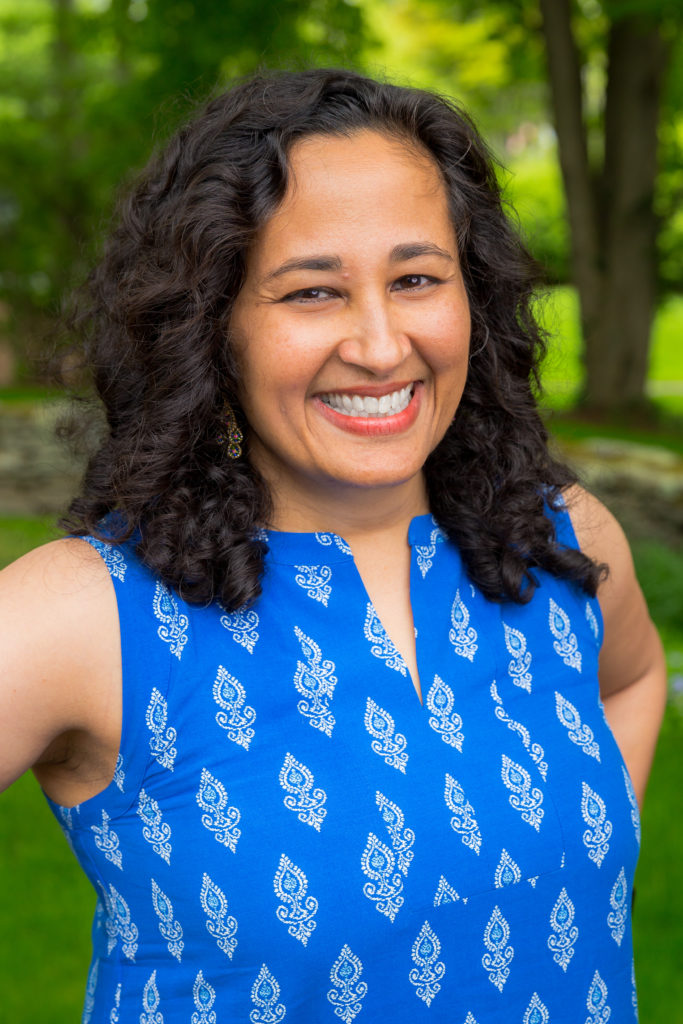
About the Author
Rajani LaRocca is a book lover, doctor, and foodie who was born in India, raised in Kentucky, and now lives in the Boston area. Her debut middle-grade novel, Midsummer’s Mayhem, is an Indian American middle-grade mashup of A Midsummer Night’s Dream and competitive baking.
For more information, visit https://www.rajanilarocca.com.
Read the Interview
Rajani LaRocca: I’m so excited to be here with you. I am, as you mentioned, a doctor and an author of children’s books. I’m a doctor for grown-ups—an internal medicine doctor in the Boston area—and I’m a children’s book author. I write middle-grade novels. So pretty much for kids ages eight to twelve. And I also write picture books.
My novels include Midsummer’s Mayhem, which is basically A Midsummer Night’s Dream meets Cupcake Wars, which came out in 2019. And its companion novel, Much Ado about Baseball, is coming out in June. Red, White, and Whole, my first novel in verse, came out in February.
My picture books include my debut Seven Golden Rings, which came out in October 2020—it’s set in ancient India and involves a math puzzle and an introduction to binary numbers. My next picture book is Bracelet’s for Bina’s Brothers, which I’m so excited to talk to you about. And then I’ve got a few more picture books coming out this year.
Bianca Schulze: Wow. So, all right. You practice medicine, and you write a lot. Before we even dive into your books, how do you manage your time to get creative and write.
Rajani LaRocca: Oh, that is such a great question, so I will just say that you know, when you love something, you always find time to do it. I knew from a very young age that I wanted to go into medicine. So that was kind of my first dream come true, is that that dream became realized, and I got to be a doctor. It wasn’t until about ten years ago that I started to go back to writing.
I took some classes, and then I met some writers. And once I met other writers, I was like, wow, you know, I have to keep doing this because they’re wonderful people, and they make me want to write more. As a mom who works outside the home, there was always a lot of juggling. When my kids were younger, I would write while they were in their piano lesson or after they had gone to sleep, or while I was parked waiting for them to come out of school. I would just kind of find time to do it.
But then, as they got older, they had a lot more homework. And my husband owns his own business, so he’s always working. So, I had more time. And nowadays, I almost feel like the two careers complement each other. One is a respite from the other because when medicine gets a little bit crazy, I can kind of delve into the imagination. And when writing gets a little bit exhausting, I can at least show up at work and feel like I know that I did something good for someone today.
Bianca Schulze: That’s incredible. Oh, my gosh. I’m just so impressed. I think that these are your words that I’m about to say. Still, I think it just collectively sums up if we would have to put all of your books together—because they’re all quite different, but a lot of them are stem-based and music, too—these are your words: stories connect us to other people across distance, time and culture. And so, no matter what you write about, I feel like each of your stories embodies that connection of people across distance, time, and culture.
You were born in India. And so, your stories have a lot of Indian culture in them. And when I was reading Bracelet’s for Bina’s Brothers, I learned about a new Hindu holiday. And, if I mispronounce this, you need to correct me, so Raksha Bandhan, which is about the bond between sisters and brothers and the fact that there’s a holiday out there about connecting brothers and sisters and siblings, I just can’t believe I didn’t know that this holiday existed. So, tell us a bit about the holiday first.
Rajani LaRocca: Yes. So, the holiday of Raksha Bandhan, or also called Rocky, which is the name of the bracelets that are given, is just really sweet. And, you know, it’s thousands of years old. Traditionally, when daughters got married, they would go and live with their husbands’ families. Right. But the brothers would continue living in the family home. And this was a symbol that, you know, that no matter what happened in the future, there would always be a bond between sisters and brothers. And I just thought it was a lovely holiday.
Now, I will tell you; I am an only child. So, when we visited with our relatives in India, I have a lot of cousins who are boys. And in India, we call each other cousin-brother and cousin-sister. So, I was really, really close to them, and I felt a lot of brotherly sisterly affection between us. And so, I just thought that this holiday was just a really sweet one to celebrate. And I loved the idea of a little sister wanting to do something special for her older brothers.
Bianca Schulze: Yeah, and I also love the way Bina is—I mean, she’s the youngest, and everybody wants to help her in her quest of making the bracelets. But I loved how independent she was and how dedicated she was to solving her problems. And so, it’s important to note here that this book is a math story as well. So, the fact that she was so dedicated to the cause of problem-solving, I thought, was an excellent example to kids. I’m assuming that was your intention to sort of create a character that showed she was going to be a problem solver.
Rajani LaRocca: Oh, absolutely. So, this is part of Charlesbridge’s Storytelling Math series. The idea is to tell stories from diverse perspectives about kids doing kid things that also illustrate mathematical principles. I hadn’t really thought about pattern making as math. But of course, it is— especially for little kids—making and recognizing patterns is a very important mathematical skill. And so, when I was thinking about that kind of concept, somehow my mind just leaped to bracelet’s. And then I was like, oh, Raksha Bandhan is the perfect holiday to showcase this whole idea of making patterns and making patterns with love for somebody else. And so, yeah, I fully intended for Bina to always be somebody who took things into her own hands and figure out how to solve these little puzzles that she came across.
Bianca Schulze: And so, this actual series from Charlesbridge are all authored by somebody different, is that correct?
Rajani LaRocca: That’s right. Yes.
Bianca Schulze: Did they approach you to write this particular story, or did you pitch the idea to them?
Rajani LaRocca: So, they had a symposium talking about math for little kids. And I was invited to be a part of that. And then we read a bunch of books and looked at the math in them. And there was an expert from a math nonprofit that talked about the math aspects of them. And then, the editors and the participants all discussed the story aspects. It was really cool. So, I wasn’t asked necessarily to write this, but I was invited to submit something if I came up with an idea. So, I sent them a draft
This idea sprang into my head like that. And then I was like, oh my goodness, I have to, I have to write this, and I have to figure out how to make this work. And then they found the perfect illustrator Chaaya Prabhat, who lives in India. She created a world. I mean, I want to live in that house. There’s so much color and so much joy exuding from every spread. I was just so, so happy.
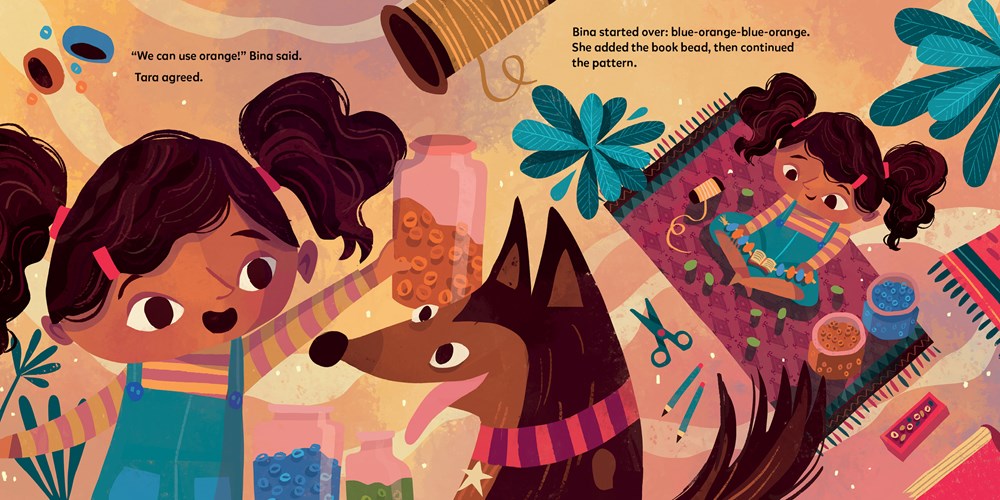
Bianca Schulze: I’m so glad you brought up Chaaya’s illustrations because I thought that same thing. From what I know of the Indian culture, the colors, and the richness, it was all there. And it’s very appealing. And I just think it’s so alluring for kids. It’s so bright and colorful. And I mean, I know not every kid probably sits down and beads, but I would say the majority of kids, both boys and girls, at some point sit down and do some beading. And so, between your words and the artwork, I just think it’s a book for everybody. And like you said, it captures the culture, and it’s got the STEM aspects. And yeah, the blend of your words and the artwork are just fantastic.
So, talking more about the illustrations, do you have a favorite one from the book?
Rajani LaRocca: So, there are so many that are really lovely. But I think my favorite is a spread where Bina talks to her brother Vijay, and he’s one of her brothers that loves to read. And that’s kind of something they bond over because he reads her stories. And there he is in this room with this blue bookshelf and all these books and everything in the room is decorated with blue and pink and orange. And there’s a beautiful rug on the floor and a little cushion that she is sitting on while she listens to the story that her older brother reads to her. And I want that room. I want the bookshelf. I want all the books. I think that might be one of my favorite spreads. And if people pay attention, especially kids, they will find that there are patterns in all the rooms that don’t only have to do with the bracelets that Bina is making. There are every-other-one patterns everywhere in the story. And it’s one of the most delightful things about this book.
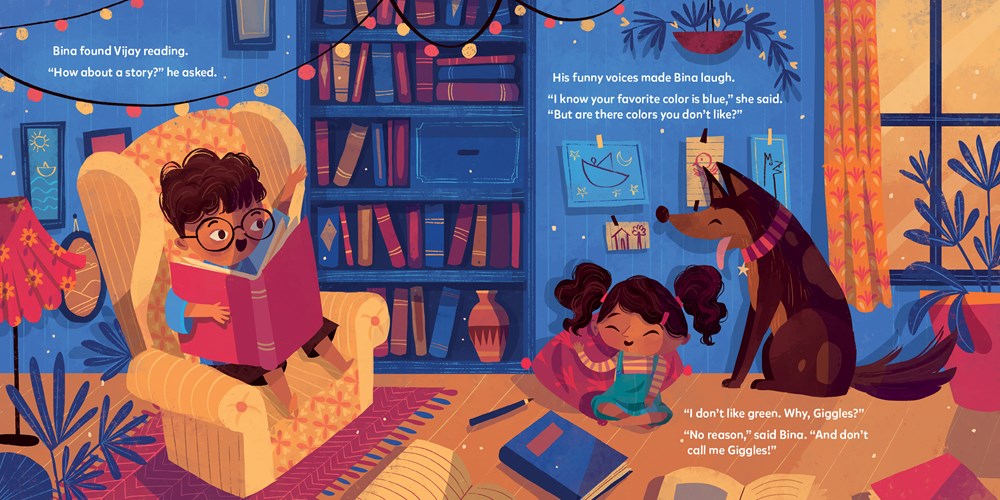
Bianca Schulze: Yeah, I loved their shirts too, because, you know, well, when she’s making the bracelets, it’s usually one color bead alternating with the next. So, say it’s orange, green, orange, green, orange, green. But then she makes the one that is, I think, blue and orange. But she does double, so two orange and then two blue, two orange and then two blue. And so, she talks about the skinnier pattern with the wider pattern. But both she and her brother have striped shirts on that are also patterned, and her shirt has the skinny stripes, and her brother has the widest stripe. And I thought that was clever, too.
Rajani LaRocca: Yes, it’s so cool. And this is the way that we all learn. Kids see things in the real world, and then they kind of apply them to whatever project they’re working on. So, I think that one of the most delightful things about STEM books is that they really make it so clear that math is everywhere and that it’s not only useful, but it’s also really kind of fun.
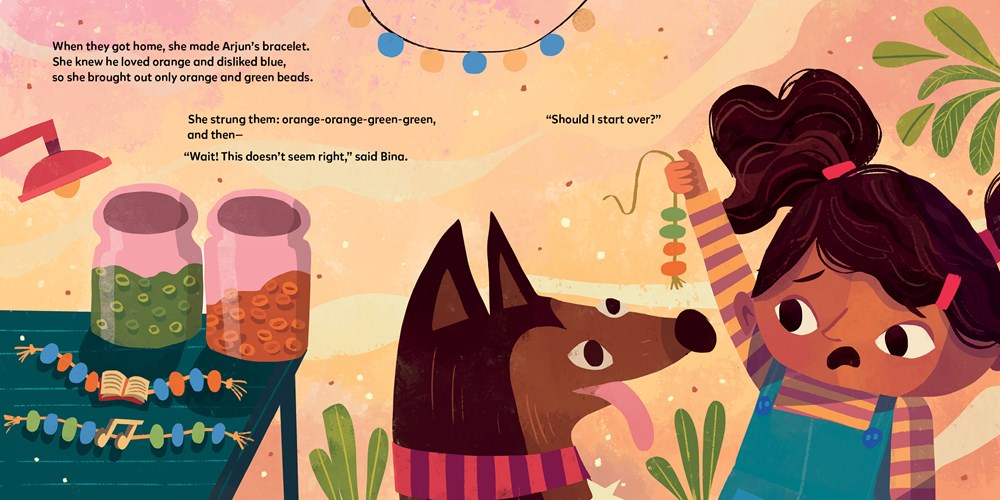
Bianca Schulze: And sometimes it’s hard to say something that’s a favorite about what you created yourself, but be bold and brave here and let me know which part you feel proudest about. Is there a specific line in there that just came together for you and just felt right in the story?
Rajani LaRocca: Yes, so I will tell you that the story’s very beginning has stayed the same from the first draft to the printed book. Which is: “Bina had three big brothers: Vijay, Siddharth, and Arjun. They sometimes annoyed her, but she loved them anyway.” I just loved that beginning because I was like, wow, this really sums up what it’s like to have siblings. I have a son and a daughter myself. So, I’ve seen this, and I just loved that feeling of They’re bigger than me. They definitely annoy me. And you and readers can see throughout the book that they kind of call her little nicknames that she doesn’t really appreciate. But she loves them. And that’s why she’s so concerned with making these bracelets. That she uses the colors that they love and avoids the colors that they don’t like and that she makes it in the pattern that she intended to. And so, having siblings, that is such a special relationship with somebody who knows you so well that they can push all your buttons and annoy you. But also like the great love that there is between them.
Bianca Schulze: Absolutely. As a mom of three kids, I think those lines nail it too. I mean, my kids love each other just as much as they annoy each other. And, you know, they are also constantly trying to do sweet things for each other. Yeah, just the idea of this entire book that celebrates siblings, and it encourages math.
We talked a bit about the marriage of the words and the illustrations and how, if you pay attention to the pages, the illustrations encourage kids to pay attention and notice. And I think being somebody that goes out into the world as a noticer is just such a fantastic thing.
There’s so much in this book to just take away beyond the fact that it’s a math story. I think you’ve done an outstanding job. I do.
I was hoping that you would just talk a bit about Red, White, and Whole. When this podcast comes out, it will be in April, National Poetry Month, and your novel is set in verse. It’s been popping up in my Instagram feed. I have a copy right here next to me. I have not had an opportunity to read it yet. And so, I would just love to have you talk just a bit about it.
Rajani LaRocca: Oh, sure. Thank you so much. Yes. I mean, it is very exciting to be talking about it during National Poetry Month. So Red, White, and Whole is a novel in verse. It’s written in free verse, and it is set in 1983. And it is about Reha, who is the thirteen-year-old daughter of Indian immigrants, and she feels torn between the worlds of her parents and her community and her friends at school.
It has 80s pop culture. So Reha is like any other American teen. She loves listening to Cyndi Lauper on the radio. She likes watching MTV and watching music videos. But her mom especially feels like there’s some things that Reha wants to do—like go to a middle school dance—that she would prefer she not do because she has other ideas about what is appropriate for a girl her age.
So, she feels torn between these two worlds. And then, her mother gets diagnosed with a type of blood cancer called leukemia. And Reha feels like her world is turned completely upside down. And she feels guilty that she was worried about fitting into these two worlds when really what she should care about was making sure that her mother was OK and thinks that if she could only be the perfect daughter, the daughter that her parents want her to be, that she could somehow save her mom’s life.
Bianca Schulze: It just sounds incredible.
Rajani LaRocca: Oh, thank you. So, it’s a book that has a lot of elements to it. It has poetry, and it has 80s pop music. It has a story from Hindu mythology, and it has a lot of imagery and metaphors. And it came to me as the metaphor of blood. That’s part of what the title refers to, and all that it means in terms of blood is heredity, biology, family, and community.
Bianca Schulze: Wow, I mean, the fact that even in a story such as Red, White, and Whole, you still also have your core of medicine. I cannot wait to start reading that one. The cover is so beautiful!
Speaker1: So, when we first sold the book, the publisher was like, OK, so we’re going to start working on covers. And I was like, what? You know, a lot of times, authors don’t get a lot of control over what their cover looks like, but they were so wonderful. I made them a dream board of all kinds of covers that I loved. And then, I shared some of the imagery from the book. Here are some things, themes that I talk about in the book. And when I saw the first sketch, I was blown away, just blown away.
So, the cover of the book itself is like a poem. There are flowers on Reha’s dress that then float up to become blood cells, representing leukemia—her mom’s cancer. And then they float even further up, and they become stars in the sky. Reha means star in Sanskrit, and her mother’s name is Poonam which means full moon, and there is a full moon as the ‘O’ in the word whole on the cover. So how perfect is that? Yeah, kind of hard to believe.
Bianca Schulze: Oh my gosh. I mean, they say you shouldn’t judge a book by its cover, but that cover just stands out. As I said, every time it pops up on my Instagram feed or and anywhere else I’ve seen it, it’s just incredible. And it does make you want to know more about the book. And anyway, it’s so clear to me that there’s so much truth in what you’re writing. If we were to put all of the books together, people would have a fair idea of who you are just based on those. Would you say that’s a fair comment?
Rajani LaRocca: Oh, absolutely. When I talk to people who are interested in writing, I tell them that. I say that even if you write fiction, which most of us do, who are in the kidlit world, that we’re trying to tell emotional truths, that there has to be some truth at the heart of your story. And that’s what makes it resonate with people. So, I hope I’m doing that with my books.
Bianca Schulze: Yes, I think you are. So, is there anything else that you would like to share with the Growing Readers listeners? Anything more about Bracelet’s for Bina’s Brothers, anything more about your upcoming books that you think we should know about?
Rajani LaRocca: Sure. You know, I hope that lots of people read Bracelet’s for Bina’s Brothers because it’s just fun and sweet and I really just love Bina. She’s so spunky, especially the way Chaaya has illustrated her. And there’s a gigantic dog in this book that is like the silliest, goofiest, tongue-sticking-out dog that you want. So, I just think it’s just so much fun to look at.
I have a few other books coming up that I didn’t mention. One is a picture book, Where Three Oceans Meet, which is coming out on August 24th with Abrams. And it’s a story about a girl who takes a road trip with her mom and grandmother to the very tip of India, to a place called Kanyakumari, where they say three oceans meet and she learns about the love and strength that mothers and daughters share. So, it’s very, very special to me. It reminds me of my own mom and my grandmother, and my daughter.
And then, on September 14th, I have a book, my first true nonfiction book called The Secret Code Inside You, that is coming out with Little Bee Books. And it’s about DNA. So, it’s a child’s first introduction to DNA, but it also touches on the limits of our genes and how our choices also make us who we are. So, I’m really excited about that.
Bianca Schulze: Sounds fascinating. Have you seen the cover? What kind of illustrations are in there?
Rajani LaRocca: Yes, Steven Salerno is the illustrator. He is just brilliant, and the art is so much fun. There’s just tons of fun in this book about comparing how come we can’t, like, suck ants up through our nose and how come we can’t fly and why can’t we breathe underwater, that kind of thing. So, there are lots of animal illustrations, and then it dives into the science. It’s really cool. It explains what a cell is and where DNA is in a cell. And it’s just so much fun. I’m completely blown away by the art in this book.
Bianca Schulze: Oh, my goodness. The number of books that you have created and the variety of your storytelling and also now nonfiction. I’m just beyond impressed, and I can’t wait for the world to get to see more of your books. Well, thank you so much for coming to chat with us. Is there anywhere specifically where our listeners can find you? I know you have a podcast of your own, too.
Rajani LaRocca: Yes. The easiest way to find out about me and my books and what’s going on is my website, which is https://www.rajanilarocca.com/. And I do a podcast with my friend Artemis Roehrig, STEM Women in Kidlit: https://stemwomenkidlit.buzzsprout.com/, a podcast where we interview women with STEM backgrounds who also create books for kids. And we have a ball. There’s a lot of laughing. There are a lot of women with STEM backgrounds who either write or illustrate or both kidlit. It’s pretty wild.
Bianca Schulze: Well, thank you again for joining us. And we look forward to the array of books that are coming out this year, and I’m sure you’ll have plenty more in 2022 as well.
Rajai LaRocca: Thank you so much, Bianca. I had such a great time talking with you, and I really appreciate it.
The transcription of this interview with Jasmine A. Stirling has been condensed and edited for readability.
Thank you for listening to the Growing Readers Podcast episode: Rajani LaRocca Discusses Bracelets for Bina’s Brothers. For the latest episodes from The Growing Readers Podcast, Follow Now on Spotify. For similar books and articles, you can check out all of our content tagged with Rajani LaRocca, Growing Readers Podcast, Indian American Books, Math, Picture Book, Siblings, and STEM Books.

